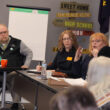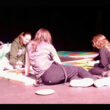Scott Swanson
Of The New Era
Teen pregnancy doesn’t stop at the school door — and that’s where Joan Pappin meets it.
Pappin runs Sweet Home High School’s Teen Pregnancy/Parenting program, in which she works with 15 girls who are pregnant or already have a child.
The purpose of the program is to help make sure the teens get the help they need to finish school.
She meets with her students at least once a week, as other school activities permit, usually during the tutorial period from 7:55 to 8:30 a.m. The session sometimes includes guest speakers or discussions of particular topics relating to the girls’ experience.
“Our primary activity right now is scrapbooking,” said Pappin, the district’s health services project director.
“It’s sort of like a quilting bee. The girls make scrapbooks for their babies and it builds connections between the girls themselves. They talk about important things without realizing it.”
Following the winter break, she said, she plans to have after-school activities on a regular basis, such as a Christmas party the girls had on Dec. 15.
This year’s group is larger and Pappin said she has approached the girls differently after simply meeting with them individually last year.
“My goal this year was really to build a support group for them,” she said. “The unity approach is to have these girls, who have so much in common, to bring them together. There really isn’t anybody else like them in the school. They need each other, in a certain aspect, to feel supported.”
Pappin, who has spent most of her nursing career in the community health field, says she also works to connect girls with resources such as the county’s Healthy Start program, which provides instruction and prenatal assistance. She also encourages them to sign up for the Women, Infants and Children (WIC) program and talks to them about their prenatal care and results of their doctor visits.
The participants in the program come from a wide variety of backgrounds and upbringings, Pappin said. One is married and another is engaged, she said. About half are working toward a high school diploma while the other half are in the GED program.
“One common thing I observe with all the girls is that they didn’t think this could happen to them,” she said. “It’s not something they planned.”




